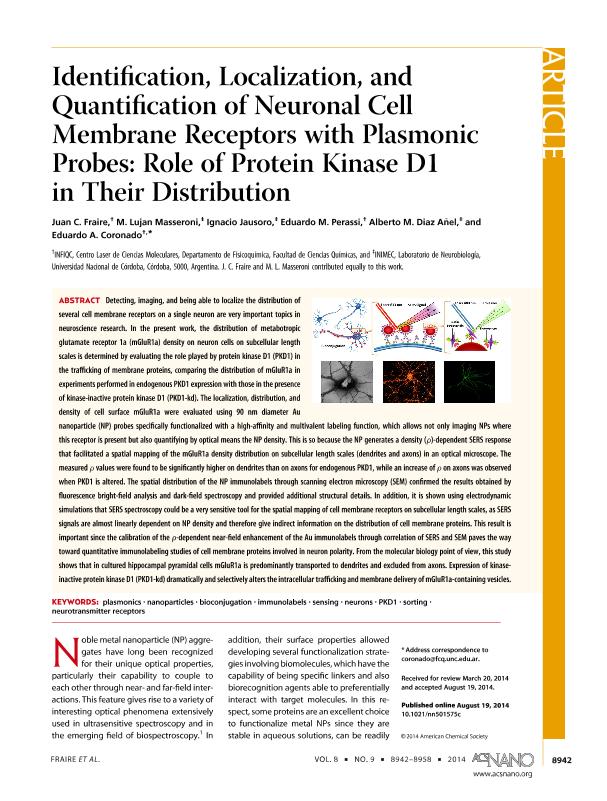Artículo
Identification, localization, and quantification of neuronal cell membrane receptors with plasmonic probes: Role of protein kinase D1 in their distribution
Fraire, Juan Carlos ; Masseroni, Maria Luján
; Masseroni, Maria Luján ; Jausoro, Ignacio
; Jausoro, Ignacio ; Perassi, Eduardo Marcelo
; Perassi, Eduardo Marcelo ; Diaz Añel, Alberto Marcelo
; Diaz Añel, Alberto Marcelo ; Coronado, Eduardo A.
; Coronado, Eduardo A.
 ; Masseroni, Maria Luján
; Masseroni, Maria Luján ; Jausoro, Ignacio
; Jausoro, Ignacio ; Perassi, Eduardo Marcelo
; Perassi, Eduardo Marcelo ; Diaz Añel, Alberto Marcelo
; Diaz Añel, Alberto Marcelo ; Coronado, Eduardo A.
; Coronado, Eduardo A.
Fecha de publicación:
09/2014
Editorial:
American Chemical Society
Revista:
ACS Nano
ISSN:
1936-0851
Idioma:
Inglés
Tipo de recurso:
Artículo publicado
Clasificación temática:
Resumen
Detecting, imaging, and being able to localize the distribution of several cell membrane receptors on a single neuron are very important topics in neuroscience research. In the present work, the distribution of metabotropic glutamate receptor 1a (mGluR1a) density on neuron cells on subcellular length scales is determined by evaluating the role played by protein kinase D1 (PKD1) in the trafficking of membrane proteins, comparing the distribution of mGluR1a in experiments performed in endogenous PKD1 expression with those in the presence of kinase-inactive protein kinase D1 (PKD1-kd). The localization, distribution, and density of cell surface mGluR1a were evaluated using 90 nm diameter Au nanoparticle (NP) probes specifically functionalized with a high-affinity and multivalent labeling function, which allows not only imaging NPs where this receptor is present but also quantifying by optical means the NP density. This is so because the NP generates a density (ρ)-dependent SERS response that facilitated a spatial mapping of the mGluR1a density distribution on subcellular length scales (dendrites and axons) in an optical microscope. The measured ρ values were found to be significantly higher on dendrites than on axons for endogenous PKD1, while an increase of ρ on axons was observed when PKD1 is altered. The spatial distribution of the NP immunolabels through scanning electron microscopy (SEM) confirmed the results obtained by fluorescence bright-field analysis and dark-field spectroscopy and provided additional structural details. In addition, it is shown using electrodynamic simulations that SERS spectroscopy could be a very sensitive tool for the spatial mapping of cell membrane receptors on subcellular length scales, as SERS signals are almost linearly dependent on NP density and therefore give indirect information on the distribution of cell membrane proteins. This result is important since the calibration of the ρ-dependent near-field enhancement of the Au immunolabels through correlation of SERS and SEM paves the way toward quantitative immunolabeling studies of cell membrane proteins involved in neuron polarity. From the molecular biology point of view, this study shows that in cultured hippocampal pyramidal cells mGluR1a is predominantly transported to dendrites and excluded from axons. Expression of kinase-inactive protein kinase D1 (PKD1-kd) dramatically and selectively alters the intracellular trafficking and membrane delivery of mGluR1a-containing vesicles.
Archivos asociados
Licencia
Identificadores
Colecciones
Articulos(INFIQC)
Articulos de INST.DE INVESTIGACIONES EN FISICO- QUIMICA DE CORDOBA
Articulos de INST.DE INVESTIGACIONES EN FISICO- QUIMICA DE CORDOBA
Citación
Fraire, Juan Carlos; Masseroni, Maria Luján; Jausoro, Ignacio; Perassi, Eduardo Marcelo; Diaz Añel, Alberto Marcelo; et al.; Identification, localization, and quantification of neuronal cell membrane receptors with plasmonic probes: Role of protein kinase D1 in their distribution; American Chemical Society; ACS Nano; 8; 9; 9-2014; 8942-8958
Compartir
Altmétricas



